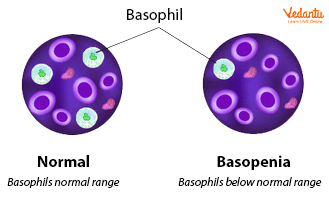How Basophils Defend the Body and Their Role in the Immune System
Basophil is a type of immune cell that contains granules with enzymes that are released during allergic reactions or asthma attacks. Basophil is a type of white blood cell and falls under the category of granulocytes along with neutrophils and eosinophils.
They are made up of a variety of substances, including histamine and heparin. As part of the body's immune defense, basophils will split open (degranulate) to release these substances when needed during an allergic reaction. These cells perform various functions to protect our bodies and there are several tests that we can do to find out the damage or any kind of disease we are suffering from.
What are Basophils?
White blood cells, also known as leukocytes, are of two types: Granulocytes and Agranulocytes, based on the presence and absence of granules.
Granulocytes are those which contain granules, like neutrophils, eosinophils, and basophils.
Granulocytes work together to cure illnesses or allergies in our bodies. The granules of each type of granulocyte contain a unique mix of chemicals and enzymes.
Basophils are the smallest granulocytes, measuring 10-14 µm in diameter.
These polymorphonuclear cells have a bilobed nucleus and cytoplasmic granules that are strongly metachromatic.
They have a short life span of 1-2 days.
These are the only leukocytes that circulate in the body containing histamine.

Image: Structure of Basophil
Function of Basophils
Basophils are one of five types of white blood cells that protect the body against infections and respond to invaders such as parasites, fungus, and cancer cells.
They are a part of the innate immune system, the immunity that is present by birth.
The human body's reactivity to allergens is controlled by basophils.
Whenever we come into contact with an allergen, they're the reason we sneeze, cough, or have a runny nose.
They can detect and eliminate some cancer cells in their early stages.
During an allergic reaction or an asthma attack, basophils also release histamine from their granules, which plays a crucial role.
They also help in protecting our bodies against microbial pathogens, viruses, helminths, etc.
They are essentially the frontline cells that attack any foreign agent that makes its way into the body.
Action of Basophils
Basophils aid in the induction of inflammatory responses.
The body's natural response to anything that could harm it is known as inflammation.
It is the body's way of telling the immune system to heal and restore damaged tissues while also protecting itself from external invaders.
Histamine and heparin are among the substances found in the granules of basophils.
Role of Histamine: It acts as a vasodilator, which means it widens blood vessels. This attracts extra immune cells to the damage or site of infection.
Role of Heparin: It acts as an anti-coagulant (blood thinner). The body makes it to prevent the formation of blood clots at the site of an injury or infection.
Basophils also target foreign agents indirectly by binding to B-cell lymphocytes.
B-cells release antibodies termed immunoglobulin E (IgE) into the bloodstream as a result of the binding.
IgE has a high anti-parasite and anti-venom effect.
Basophils Role in Allergies
An allergy is when the immune system reacts abnormally to a substance or event that is otherwise safe.
Basophils release histamine, which is one of the main causes of allergic symptoms.
Basophils and related cells called mast cells break open when the body is exposed to an allergen (allergy-causing chemical).
Histamine causes blood vessels to dilate, allowing fluid to flow into the surrounding tissues.
As those tissues grow and become inflammatory, they can cause redness and swelling of the skin in the form of rashes and itching.
Levels of Basophils
A test called a white blood cell (WBC) count is used to determine the concentration of white blood cells, of which basophils make up between 0.5 and 1 percent.
The absolute basophil count (ABC) is a test that measures the actual number of basophils in cubic millimetres (mm3).
A basophil's normal range is 0.5% to 1% of your total white blood cell count. In healthy humans, this equates to zero to 300 basophils per microliter of blood.
If your basophil level is higher than this, you may have allergic reactions, chickenpox, collagen vascular disease, hyperthyroidism, or bone marrow disease.
The lower level of basophils indicates cancer, acute infection, and thyrotoxicosis.
Basophils in blood tests might be high or low in response to specific conditions or treatments.
Basophilia refers to an excessively high basophil count, while basopenia refers to an abnormally low basophil count.

Image: Basopenia
Conclusion
Basophils are granulocytes, a type of white blood cell. Basophils are one of the first lines of defense against illnesses, including parasites, as part of the innate immune system. Infections, hyperthyroidism, and chickenpox can all produce high basophilia, while acute infections and cancer treatments can all cause low basophilia. Basophils also play an important part in causing allergies by releasing histamine into the bloodstream, which is an allergy-causing substance.


FAQs on Basophils: Structure, Function, and Importance in Biology
1. What are basophils and what are their key structural features?
Basophils are a type of white blood cell (leukocyte) and are the least common granulocyte, making up less than 1% of total white blood cells. Their key structural features include an S-shaped or bilobed nucleus, which is often hidden by large, coarse cytoplasmic granules. These granules stain a dark purple or blue with basic dyes, a key identifying feature.
2. What is the main function of basophils in the body?
The primary function of basophils is to initiate and mediate inflammatory and allergic reactions. They achieve this by releasing potent chemicals from their granules. Key secretions include histamine, which dilates blood vessels to increase blood flow to damaged tissue, and heparin, an anticoagulant that prevents rapid blood clotting. They are vital in the immune response against parasites and allergens.
3. How do basophils contribute to an allergic reaction?
During an allergic reaction, the immune system produces antibodies known as Immunoglobulin E (IgE) that bind to the surface of basophils. When you are exposed to that same allergen again, it attaches to the IgE on the basophils. This binding triggers the basophils to degranulate, a process where they release their granules' contents, including large amounts of histamine. This release causes the classic symptoms of an allergy, such as itching, swelling, and inflammation.
4. What is the difference between basophils and mast cells?
While both basophils and mast cells are crucial in allergic responses, they differ in several ways:
- Location and Maturity: Basophils mature fully in the bone marrow before circulating in the bloodstream. In contrast, mast cells leave the bone marrow in an immature state and mature only after they settle in connective tissues.
- Mobility: Basophils are motile cells found circulating in the blood, while mast cells are typically non-motile and reside within tissues.
- Nucleus: Basophils possess a distinctive lobed nucleus, whereas mast cells have a round, unlobed nucleus.
- Lifespan: Basophils have a very short lifespan of a few days, while mast cells can survive for weeks or even months.
5. Why are these cells named 'basophils'?
The name 'basophil' provides a clue to its laboratory identification. The term breaks down into 'baso-' (referring to basic or alkaline) and '-phil' (meaning 'to love'). Therefore, a basophil is a cell that is 'base-loving'. This is because its prominent cytoplasmic granules have a high affinity for basic dyes, like haematoxylin, which stain them a characteristic deep blue-purple, making them easy to see under a microscope.
6. What does a high or low count of basophils in a blood test signify?
Deviations from the normal basophil range (0.5-1% of white blood cells) can indicate specific health issues.
- A high basophil count (basophilia) may be associated with chronic inflammation, allergic reactions, hypothyroidism, or certain blood cancers like chronic myeloid leukaemia.
- A low basophil count (basopenia) can be seen during acute infections, hyperthyroidism, or as a reaction to steroid treatments, as the cells are either used up or their production is suppressed.
7. What is the importance of the chemicals stored in basophil granules?
The chemicals, or mediators, stored within basophil granules are essential for the body's immediate immune and inflammatory responses. The two most important are:
- Histamine: This chemical increases the permeability of capillaries and causes vasodilation (widening of blood vessels). This allows other immune cells to quickly reach a site of infection or injury, but also causes the swelling and redness seen in inflammation.
- Heparin: This is a natural anticoagulant that prevents the formation of blood clots, ensuring that blood continues to flow freely to an inflamed area.










